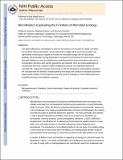Microfluidics Expanding the Frontiers of Microbial Ecology
Author(s)
Rusconi, Roberto; Stocker, Roman; Garren, Melissa
DownloadStocker_Microfluidics expanding.pdf (1.321Mb)
OPEN_ACCESS_POLICY
Open Access Policy
Creative Commons Attribution-Noncommercial-Share Alike
Terms of use
Metadata
Show full item recordAbstract
Microfluidics has significantly contributed to the expansion of the frontiers of microbial ecology over the past decade by allowing researchers to observe the behaviors of microbes in highly controlled microenvironments, across scales from a single cell to mixed communities. Spatially and temporally varying distributions of organisms and chemical cues that mimic natural microbial habitats can now be established by exploiting physics at the micrometer scale and by incorporating structures with specific geometries and materials. In this article, we review applications of microfluidics that have resulted in insightful discoveries on fundamental aspects of microbial life, ranging from growth and sensing to cell-cell interactions and population dynamics. We anticipate that this flexible multidisciplinary technology will continue to facilitate discoveries regarding the ecology of microorganisms and help uncover strategies to control microbial processes such as biofilm formation and antibiotic resistance.
Date issued
2014-05Department
Massachusetts Institute of Technology. Department of Civil and Environmental Engineering; Parsons Laboratory for Environmental Science and Engineering (Massachusetts Institute of Technology)Journal
Annual Review of Biophysics
Publisher
Annual Reviews
Citation
Rusconi, Roberto, Melissa Garren, and Roman Stocker. “Microfluidics Expanding the Frontiers of Microbial Ecology.” Annu. Rev. Biophys. 43, no. 1 (May 6, 2014): 65–91.
Version: Author's final manuscript
ISSN
1936-122X
1936-1238